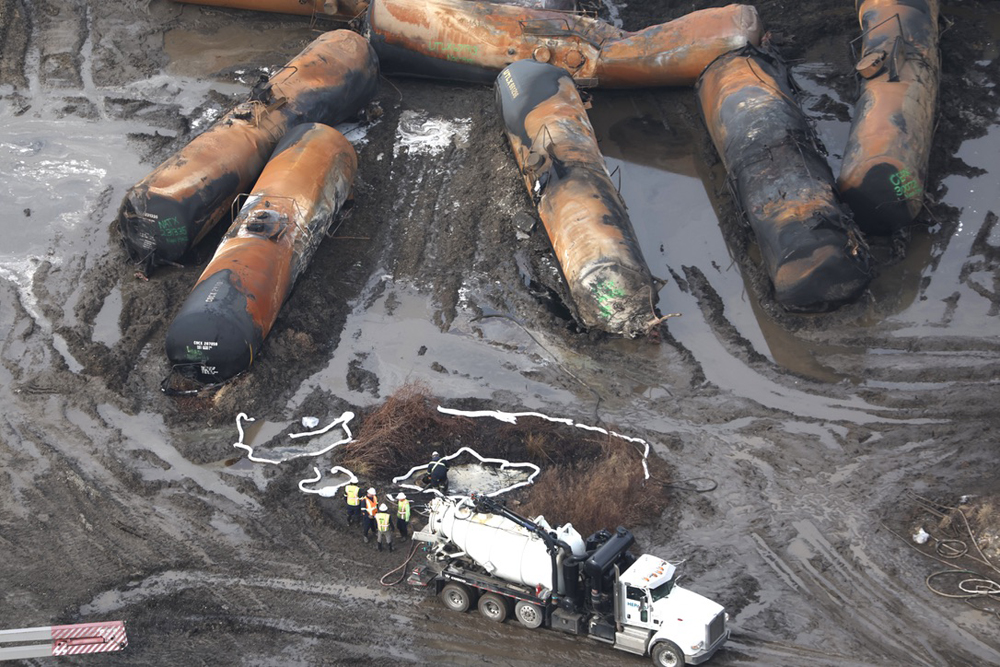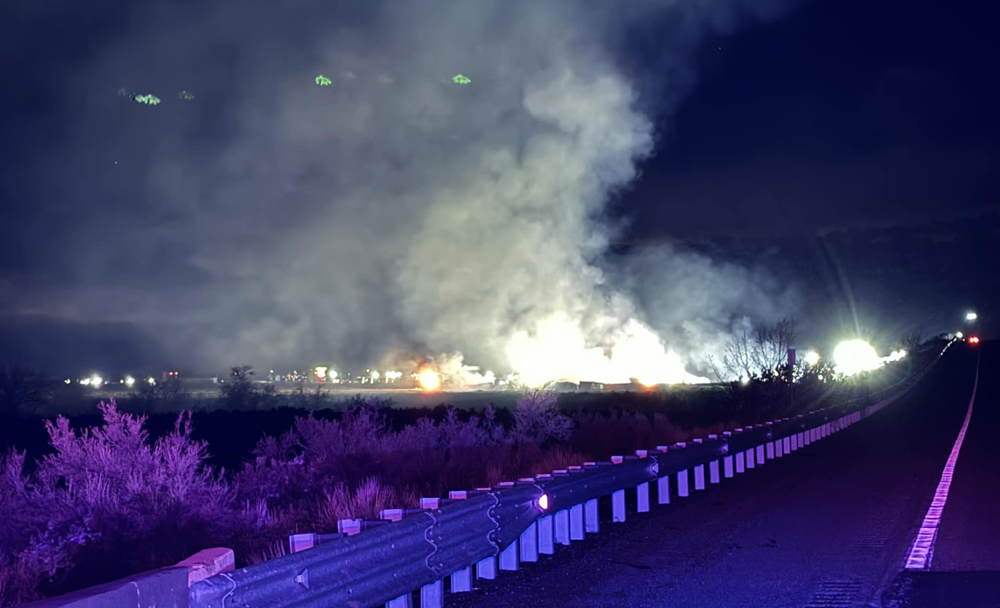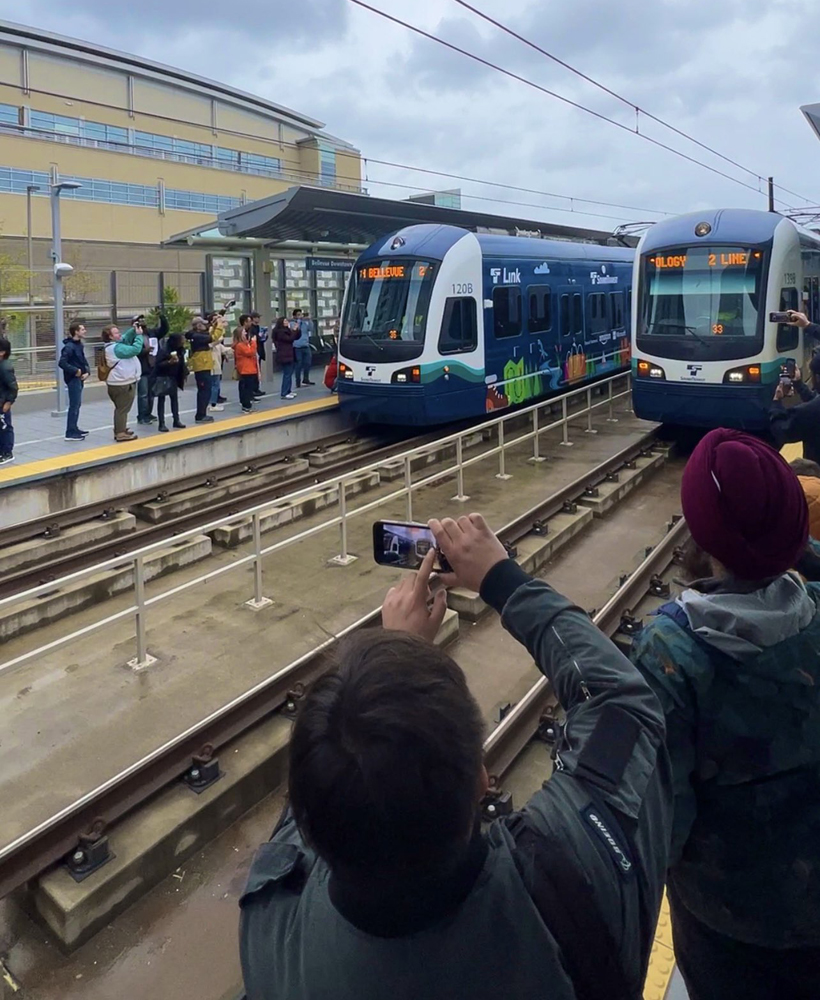
WASHINGTON — Norfolk Southern hot box detectors recorded increasing wheel bearing temperatures on the car suspected of causing the disastrous derailment in East Palestine, Ohio, the National Transportation Board said today in its preliminary report on the Feb. 3 wreck.
But the temperature readings never reached the critical threshold that would have tripped an alarm and required the crew to stop the train — until moments before the derailment, when merchandise train 32N passed the detector at milepost 49.81 in East Palestine.
“Train 32N passed three [hot box detector] systems on its trip before the derailment,” the report states. “At MP 79.9, the suspect bearing from the 23rd car had a recorded temperature of 38°F above ambient temperature. When train 32N passed the next HBD, at MP 69.01, the bearing’s recorded temperature was 103°F above ambient. The third HBD, at MP 49.81, recorded the suspect bearing’s temperature at 253°F above ambient.”
The East Palestine detector alerted the crew with an audible message instructing them to stop the train to inspect the hot axle. Because 32N was closely following a train, the engineer was already slowing the train with dynamic brakes when the alert was sounded.
“The train engineer increased the dynamic brake application to further slow and stop the train,” the NTSB said. “During this deceleration, an automatic emergency brake application initiated, and train 32N came to a stop.”
The emergency brake application was triggered by the derailment as air brake hoses separated.
At 8:54 p.m. 38 of the train’s 149 cars derailed on main track 1. The train was operating with two locomotives on the head end and a distributed power unit between cars 109 and 110. The 9,309-foot train was moving at 47 mph in 50-mph territory at the time of the derailment.
The 17,977-ton consist included 20 placarded hazardous materials tank cars transporting combustible liquids, flammable liquids, and flammable gas, including vinyl chloride, the NTSB said.
First responders put out the resulting fire by Feb. 5, but five derailed DOT-105 tank cars carrying 115,580 gallons of vinyl chloride concerned authorities because the temperature inside one of the cars was still rising.
“This increase in temperature suggested that the vinyl chloride was undergoing a polymerization reaction, which could pose an explosion hazard. Responders scheduled a controlled venting of the five vinyl chloride tank cars to release and burn the vinyl chloride, expanded the evacuation zone to a 1-mile by 2-mile area, and dug ditches to contain released vinyl chloride liquid while it vaporized and burned,” the NTSB said. “The controlled venting began about 4:40 p.m. on February 6 and continued for several hours.”
The controlled burn caused the huge plume of black smoke that rose above the town.
NTSB investigators have identified and examined the first railcar to derail, a covered hopper carrying plastic pellets. It was the 23rd car in the consist.
“Surveillance video from a local residence showed what appeared to be a wheel bearing in the final stage of overheat failure moments before the derailment,” the NTSB said. “The wheel bearing and affected wheelset have been collected as evidence and will be examined by the NTSB. The vinyl chloride tank car top fittings, including the relief valves, were also removed and examined by the NTSB on scene. The top fittings will be shipped to Texas for testing under the direction of the NTSB.”
The NTSB is searching for additional surveillance video footage that may have been taken at businesses and homes along the NS Fort Wayne Line. Investigators also want to pinpoint the precise location of the video that showed the flaming truck of the hopper car.
NTSB Chair Jennifer Homendy, speaking at a news conference today, said there was no evidence that track defects, operational issues, or the actions of the crew played a role in the derailment.
The NTSB says its investigation will focus on the wheelset and bearing that failed; tank car design and derailment damage; a review of the accident response, including the venting and burning of the vinyl chloride; railcar design and maintenance procedures and practices; NS use of wayside defect detectors; and NS railcar inspection practices.
“We know what derailed the train,” Homendy said of the catastrophic wheel bearing failure. But the investigation will take 12 to 18 months because the NTSB has a lot of questions, which leads to additional questions, as part of its methodical probe.
The NTSB will conduct a rare investigative field hearing this spring, Homendy said. Field hearings allow the board to hear from invited witnesses, discuss what occurred, and how to prevent similar accidents, she explained.
The derailment and its aftermath have become a political football, with Republicans saying the Biden administration hasn’t done enough to help displaced residents and Democrats saying the Trump administration backed off on much-needed safety regulations.
Homendy was asked what she thought of former President Trump’s visit to East Palestine. “Enough with the politics on this. Enough with the politics. I don’t understand why this has gotten so political. This is a community that is suffering. This is not about politics … this is about addressing their needs, their concerns,” she said.
“Safety is the only thing we care about,” she added. “Politics is left at the door.”
Homendy applauded Department of Transportation recommendations, made this week, that railroads provide first responders with real-time information about hazardous materials that are being hauled through their communities. The hazardous materials placards on the tank cars that derailed in East Palestine melted in the fire, she noted, so first responders initially did not know what they contained.
Homendy said people need to know whether they live or work near a hazmat route so that they can better recognize and respond to an emergency in the event of a toxic release.
NS CEO Alan Shaw appeared on a CNN town hall meeting last night, where residents of East Palestine were able to question him, Ohio Gov. Mike DeWine, and state health officials.
Based on feedback from residents, NS has modified its plans to remove contaminated soil beneath its tracks at the derailment site. Work has begun on one track.
“Our original plan would have effectively and safely remediated the soil under our tracks. As I listened to community members over the past two weeks, they shared with me their concerns about that approach,” Shaw said in a statement. “I appreciate the direct feedback, and I am addressing it. In coordination with Ohio and U.S. Environmental Protection Agencies, we are changing our remediation plan to temporarily remove the tracks so we can excavate the soil. It is important to me that the members of this community have confidence in Norfolk Southern’s remediation efforts and that we are working closely with local, state, and federal agencies.”
— Updated at 4:35 p.m. CST with information from NTSB press conference.














The engineer was already dynamic braking the train when the emergency application occured and that train bunching I believe was the cause of the accordian type pile up. Had the Power braking method been used I believe the train would’ve stayed more in line.
It would appear that the “the critical threshold that would have tripped an alarm” and the failure temperature of the axle were too close. I like CSX’s way of noting trending temperatures so the RR can see an incipient hotbox.
The other question is, with modern air brakes, how did 1/3 of the train end up in the pileup?
All of the brakes do not apply instantly. They are triggered when the air drops in the train line. It takes a while for the pressure drop goes 9,000 feet.
Is it known that it was not on fire at the Salem detector? The video was also from Salem.
The 103 temp is above ambient temp. What this poster wonders if there had been a detector at ~~ MP59 would the Temp been high enough to warrant a stop? The various juries are certainty going
to want to know?
It seems odd to me that a journal that is on fire would be only at a temperature of 103 degrees. A person can have a fever warmer than that.
The point at which the measured temperature of 103° the bearing was not on fire. That occurred later.
Regarding my previous comment concerning the NS threshold for hot journal alarms, I have now read the NSTB report released today. It appears that the two previous detectors did not reach the threshold for an alarm broadcast.
The NS temperature range rules are in the report link
A factor that has not, as yet, been brought up in this discussion, nor has the NTSB stated, whether the DDs along this route are “linked”.
Most DD installations act independently and only announce an audible radio report when the alarm threshold is met.
“Linked” DD installations, such as the ones on the CSX Chicago line (my former territory), compare readings on successive measurements in order to identify a “trending hotbox”.
When such rising temperatures are identified, the system will alert the dispatcher who then will contact the crew to set out the car. This happened with a train that I was running only once in my career, but it is a very helpful tool.
I am curious as to what the threshold is for the NS hot journal detectors to broadcast a warning. Did the two previous detectors that recorded increasing temperatures not broadcast?
The important question is what happened when. OK dynamic brakes were first. Then you have derailment and emergency braking. Which happened first? The axel fire could have burned the air hose or the derailment could have broken the air line. leave it to NTSB to figure the timeline second by second.
Can you explain to me what difference that makes?? A journal failure is a journal failure. Sounds like a waste of time and taxpayer money figuring that out.
Jay I also question why a red flag wasn’t raised with the rapid rise in temp between detectors. But don’t be too hard on dispatchers. Desks have been consolidated and territories extended for each dispatcher. The dispatcher for this line covers from Berea, west of Cleveland, all the way to Enon, PA. I know in my own experience I’ve heard dispatchers contact a train and inform them a car is trending hot. How that information is delivered to a dispatcher I am not aware of. But one must remember the Class 1’s want to eliminate jobs and replace those with technology which failed miserably in this case.
NS Cut a hog in the ass and will pay through the nose. Everything according to their rule book, but train should have been stopped tor inspection after two detectors indicated rising temperature. Usually, it would be nothing more than sticking brakes, nothing found, and /or faulty HBD read. Third d/d got it right, but rapid failure already had occurred. This report should have been serially released as things progressed. Instead, misinformation, lack of plain language explanation, and thus rumors and politics turned into a frenzied circus that could have been headed off.
103°F above ambient is not enough to trigger an alert? Why is that?
Seems to me that, with all the “telemetry” available in every system under the sun, that this info could/should have been transmitted back to the dispatch center, where the precipitous rise in bearing temperature over an 11-mile distance would be a clear indicator of something that would require investigation.
Course, you’d have to stop the train, get out and inspect the consist, and well, that would certainly throw sand into the gears of that well-oiled machine that is PSR, now wouldn’t it?
I don’t want to diminish the hard work of certain people in the industry, but if you get a bunch of defect detector alerts and a high percentage are either false, incorrect as opposed to accurate, you tend to grow a habit of either ignoring them or putting them off until the consist has to stop naturally (like in a yard)
It was mentioned in a another website article that many of the Class 1’s defect detectors themselves are either old, haven’t been certified or maintained in some time, or simply allowed to misread until the next maintenance cycle to save $.
A question for someone in rail operations, when a hi-rail comes through to check on rail consistency, isn’t their a laser or object that forces the detector into a positive result so that the system is checked for accuracy? Just wondering how often they actually get checked?